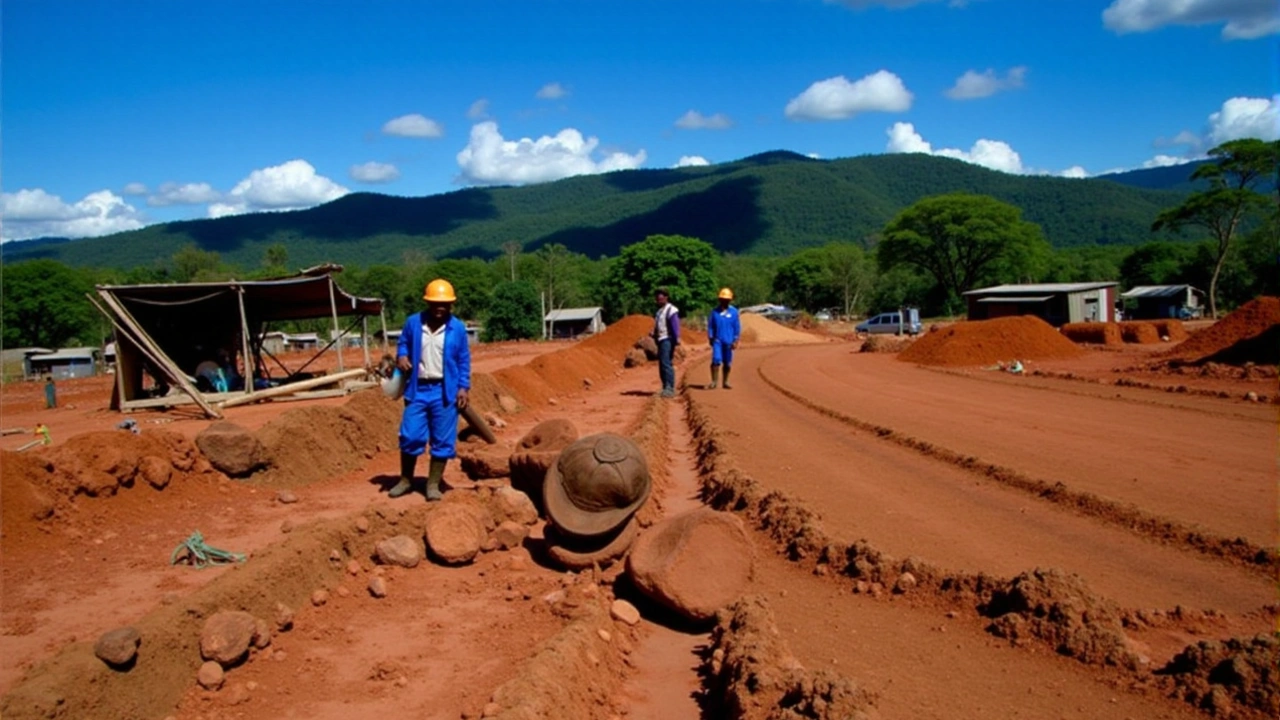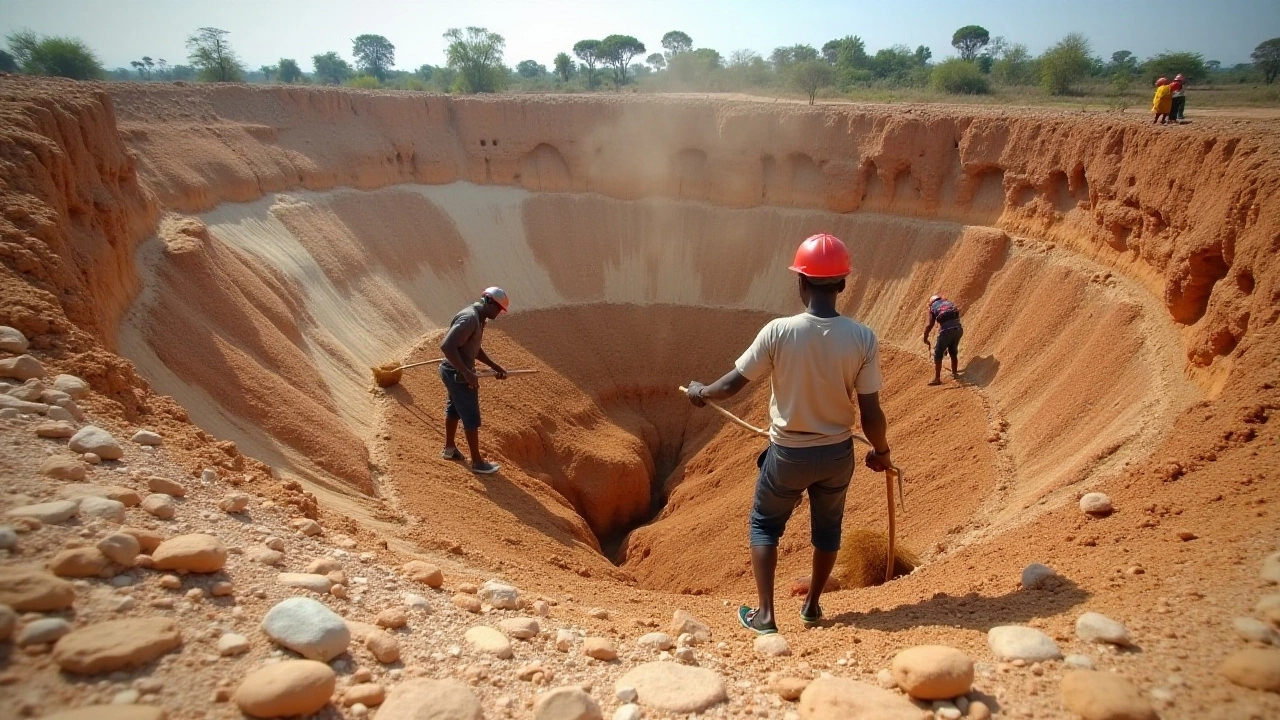Zimbabwe's Mining Sector Faces Challenges: Pessimistic Forecasts for 2025 Amid Rising Costs
 Oct, 11 2024
Oct, 11 2024
Zimbabwe's Mining Sector: A Deep Dive into Upcoming Challenges
As the year 2025 looms, Zimbabwe's mining industry is facing an array of challenges that have cast a shadow of pessimism over its future prospects. A recent report by the "Chamber of Mines of Zimbabwe" highlights a critical concern among miners in the country: the anticipation of decreased profitability. This outlook is primarily driven by an increase in production costs and a sobering market forecast for key minerals like platinum and lithium. The general sentiment echoes the statement of Isaac Kwesu, the Chief Executive Officer of the Chamber of Mines of Zimbabwe, who expressed that rising costs are indeed dampening the profitability of mining operations.
One of the significant issues plaguing the sector is the expected rise in production costs, projected to increase by an average of 8% over the next fiscal year. This is a steep climb that could take a toll on operations already operating on thin margins. Higher costs are expected to be driven by various factors including the increasing price of inputs, transportation costs, and escalating energy demands. Over the coming two years, these energy requirements are anticipated to surge from 600 megawatts per day to a staggering 800 megawatts. For a sector that is heavily reliant on energy, this poses a formidable challenge.
Currency Instability and Economic Impact
One cannot overlook the complications introduced by Zimbabwe's currency situation. In a significant move, the country devalued its gold-backed currency, the Zimbabwe Gold (ZiG), in September, offering it to banks at a rate 44% lower compared to the market-dominant dollar exchange rate. The advent of ZiG in April, meant to replace the Zimbabwean dollar, was envisioned as a solution to the nation’s economic instability. However, the devaluation highlights ongoing challenges with maintaining currency stability, which in turn creates uncertainties within the mining sector. The fluctuating currency positions miners with an additional layer of risk that has to be managed carefully.
The government's policy direction and regulatory changes further compound the sector’s apprehension about the future. Zimbabwe, a leading producer of lithium in Africa, had initially set a deadline until March 2024 for lithium miners to present concrete plans for the development of battery-grade lithium domestically. This policy, designed to encourage value addition and local processing, was seen as a step towards bolstering the nation's industrial capacity. However, the mandate was eventually loosened in response to international market developments.
Global Market Dynamics and Their Influence
The global market landscape for lithium has changed rapidly, primarily due to an oversupply from China coupled with dwindling demand for electric vehicles, leading to an astonishing 80% plunge in prices over the previous year. This abrupt downturn has squeezed revenues and aggravated concerns among Zimbabwean lithium mining companies. While demand for electric vehicles drives lithium consumption, fluctuations in global demand and supply can create ripples affecting producer countries worldwide.
Adding to the complexity is Zimbabwe's reliance on its mining sector as a cornerstone for economic stability and growth. As international economic climates shift and local conditions vacillate, the interplay between internal policy adjustments and external market pressures will be pivotal in shaping the future of Zimbabwe's mining industry. It remains crucial for miners, policymakers, and investors to synergize their efforts to navigate the intricate landscape, ensuring sustainable operations that can withstand both local and international ebbs and flows.

The Road Ahead for Zimbabwe's Mining Industry
Looking ahead, the Zimbabwean mining sector must brace itself for strategic transformation. With a clear need for technological innovation and infrastructure investment, players in the industry will have to innovate to stay competitive. Developing cost-efficient mining techniques and improving energy efficiency will be fundamental in combatting the rising cost of production. Simultaneously, fostering robust international partnerships could provide the sector with the resilience required to weather monetary fluctuations and volatile market conditions.
At the policy level, strategic reforms aimed at stabilizing the currency and incentivizing investment in domestic value addition could significantly alter the current trajectory, opening new opportunities for growth and sustainability. This includes potential benefits from exports, which could boost foreign exchange earnings, and leveraging abundant mineral resources to enhance local manufacturing capabilities. Policymakers have an opportunity to craft a conducive environment that facilitates seamless mining operations amidst external challenges.
Ultimately, while the near-term outlook points to various challenges, the resilience of Zimbabwe’s mining industry will play a crucial role in determining its long-term prosperity. By addressing both the pressing issues and long-term strategic goals, Zimbabwe can secure its stance as a leading mining nation on a global scale, ensuring prosperity for its miners while contributing significantly to the nation's economy.

abi rama
October 11, 2024 AT 14:06It's definitely a tough spot for the mining community, but I still see some room for optimism. The sector can lean on technological upgrades to shave off a few percent of those rising costs. Diversifying into value‑added processing could also cushion the blow from currency swings. If investors stay patient, we might still see a gradual rebound as global demand steadies.
Megan Riley
October 12, 2024 AT 01:13Wow!! The numbers are scary, but don't let that dim your hope!! With a bit of creativity and some smart partnerships, miners can navigate these choppy waters. Even a tiny tweak in energy use can save big bucks over time!! Keep pushing, and remember: every challenge is a hidden opportunity!!
Lester Focke
October 12, 2024 AT 12:19The recent prognostications concerning Zimbabwe's mining sector merit rigorous scrutiny. An 8% escalation in production costs, as delineated in the Chamber of Mines report, portends a deleterious impact on profit margins. Moreover, the concurrent depreciation of the gold‑backed ZiG currency introduces an additional vector of fiscal volatility. It is incumbent upon policymakers to address the lattice of macro‑economic variables that underpin mining viability. Energy consumption, projected to surge from six hundred to eight hundred megawatts per day, substantiates a pressing exigency for infrastructural upgrades. The nexus between energy pricing and operational expenditure cannot be overstated. In parallel, the global lithium market has experienced an unprecedented eighty percent contraction in price levels, a phenomenon attributable to oversupply dynamics in China. This contraction inevitably erodes revenue streams for lithium producers in Zimbabwe, diminishing incentives for domestic processing initiatives. The initial regulatory mandate to develop battery‑grade lithium domestically, though well‑intentioned, appears to have been attenuated in response to external market forces. Such regulatory flexibility, whilst pragmatic, may engender uncertainty among investors seeking long‑term commitments. It is therefore advisable for the Ministry of Mines to promulgate a transparent, phased roadmap that reconciles market realities with strategic aspirations. Investment in cost‑efficient extraction technologies and renewable energy sources could ameliorate the cost curve. Likewise, forging robust partnerships with international mining conglomerates may furnish the requisite capital and expertise. From a macro‑economic perspective, stabilizing the ZiG exchange rate would bolster confidence across the extractive value chain. In summation, a holistic approach that interweaves fiscal policy, energy strategy, and market diversification is indispensable for safeguarding the sector's resilience.
Naveen Kumar Lokanatha
October 12, 2024 AT 23:26The report underscores a classic case of external shocks amplifying internal inefficiencies. While the devaluation of ZiG adds to the cost burden, it also highlights the need for a more resilient fiscal framework. Stakeholders should consider hedging strategies and perhaps explore renewable energy options to curb the projected 800 MW demand. A collaborative approach between government and private firms could pave the way for sustainable growth.
Alastair Moreton
October 13, 2024 AT 10:33These projections read like a cautionary tale.
Surya Shrestha
October 13, 2024 AT 21:39Indeed, the forecast delineates a rather unsettling trajectory; however, one must also acknowledge the adaptive capacity of seasoned mining enterprises, which can mitigate adverse outcomes through strategic capital allocation and operational agility.
Rahul kumar
October 14, 2024 AT 08:46From a practical standpoint, miners could start by conducting energy audits to pinpoint wastage; even modest savings on power bills can offset a chunk of that 8 % cost hike. Pair that with bulk purchasing agreements for inputs, and you’ll see a tangible improvement in the bottom line.
mary oconnell
October 14, 2024 AT 19:53Ah, the silver lining-because optimism always solves a power crunch and a devalued currency, right? One might as well sprinkle a little pixie dust on those mining rigs and watch the costs vanish. In reality, without systemic reforms, hope alone won’t keep the lamps lit.
Michael Laffitte
October 15, 2024 AT 06:59Wow, reading this feels like watching a blockbuster where the heroes are the miners fighting against a villainous rise in costs and a jittery currency. If we rally together, maybe we can script a happy ending where innovation saves the day.
sahil jain
October 15, 2024 AT 18:06The drama is real, and the stakes are high 🙂. Energy efficiency projects could be the plot twist we need, turning the narrative from bleak to hopeful.
Bruce Moncrieff
October 16, 2024 AT 05:13It makes me wonder how much of the cost surge is driven by imported equipment versus local inefficiencies. If we could isolate those variables, targeted interventions might slash expenses dramatically.
Dee Boyd
October 16, 2024 AT 16:19Beyond the numbers lies a deeper ethical dilemma: should we prioritize profit in an industry that already strains local communities and ecosystems? Sustainable practices must be woven into any revival plan, lest we perpetuate harm for short‑term gains.
Carol Wild
October 17, 2024 AT 03:26Honestly, the whole discourse feels like a reheated stew of buzzwords and half‑baked solutions; you get the same old spiel about diversification, energy audits, and “strategic partnerships” without any concrete roadmap. It’s as if every analyst reads from the same template, sprinkling in a dash of optimism just to keep the reader appeased. Meanwhile, the miners on the ground are left juggling soaring electricity bills, a volatile currency, and a market that’s as fickle as the weather. If you ask me, the industry needs more than glossy reports-it needs grassroots innovation and real policy courage. But of course, that’s easier said than done in a landscape riddled with bureaucracy and endless red tape.
Rahul Sharma
October 17, 2024 AT 14:33While the critique raises valid points, dismissing all policy initiatives as mere rhetoric undermines the tangible progress made through recent fiscal stabilisation measures; indeed, the government’s commitment to refine the ZiG framework demonstrates a willingness to engage constructively with stakeholders.
Emily Kadanec
October 18, 2024 AT 01:39Actually, the 8% cost increase isn’t just a random figure-it aligns with the global trend of rising commodity prices, which anyone following the market can see. If you look at the data, it’s clear that miners will need to adapt quickly.
william wijaya
October 18, 2024 AT 12:46I feel your frustration; navigating these shifting economic currents can be overwhelming. Remember, sharing experiences and solutions within the community can lighten the load for everyone.